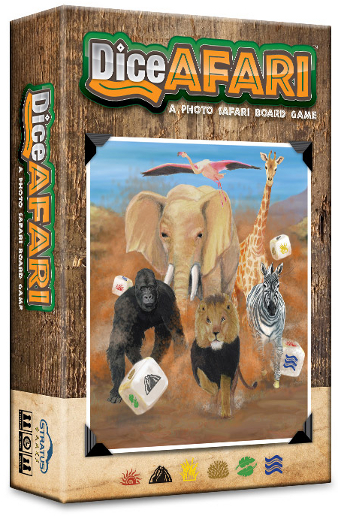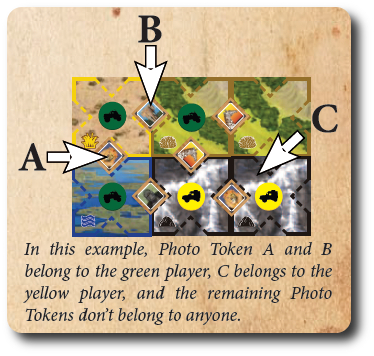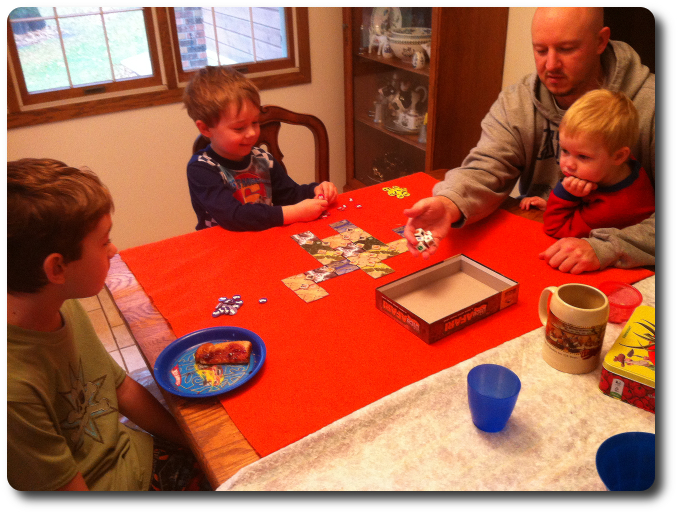
The Basics:
- For ages 4 and up (publisher suggests 8+)
- For 2 to 4 players
- Approximately 15 minutes to complete
Geeks Skills:
- Counting & Math
- Logical & Critical Decision Making
- Pattern/Color Matching
- Worker Placement & Area Control
Learning Curve:
- Child – Easy
- Adult – Easy
Theme & Narrative:
- Set out on a photo safari adventure and track down some of the most wild and elusive animals!
Endorsements:
- Gamer Geek rejected!
- Parent Geek approved!
- Child Geek approved!
Overview
The land is wild and beautiful, as are the animals that live in it. Take up your camera and travel to remote parts of the region in hopes of being able to take that award-winning nature shot you always wanted. Visit lush jungle mountains, tall grassed plains, and dry deserts in search of the elusive wild animals. Once found, take your shots as quickly as possible before others do! In the end, the player who has taken the most pictures and traveled the most ground will have truly experienced the greatest of safaris!
DiceAFARI, by Stratus Games, is comprised of 18 Safari tiles (scrubland, jungle, desert, mountain, savanna, and marsh; 3 of each), 28 Photo tokens (lion, giraffe, elephant, and gorilla; 7 of each), 4 Safari Dice (six-sided dice depicting 1 of the 6 possible regions on each die face), 1 Bonus die (six-sided die with values 1 to 4), 72 Travel tokens (in colors red, blue, yellow, and green; 18 of each), and 14 Map cards (including 2 blank Map cards for customization). All the components are of excellent quality, as is what we’ve come to expect from Stratus Games.

Getting Ready to Travel
To set up the game, first collect and shuffle the Map cards. Have one player randomly select one of the Map cards. Or, if preferred, simply select one of the Map cards to use.
Second, collect and shuffle the Safari tiles. Now create the pattern noted on the Map tile using the Safari tiles. Any Safari tiles not used are discarded for the duration of the game.
Third, collect and randomly select 1 Photo tile at a time, placing the tile face-up on any space between two or more adjacent Safari tiles. There is a diamond-shaped space that is created when two or more Safari tiles are placed next to each other. Use these as a guide to show you where the Photo tiles should be placed.
Fourth, have each player select one of the four available Travel token colors and take all the tokens of that color, placing them in front of them.
Fifth, decide who should go first and hand them the 4 Safari dice and the 1 Bonus die.
You are now ready to play! Start your vehicle and make your way into the wilderness!
On Safari
The game is played in rounds with as many rounds as it takes until the endgame is triggered. Until then, all the players will take a single turn per round, with player turn order going clockwise. On a player’s turn, they will complete the following sequential steps.
Step 1: Roll the Safari and Bonus Dice
The player takes all 4 of the Safari dice and the single Bonus die and rolls them together. The Bonus die is set aside and can no longer be rolled for the duration of the player’s turn. The 4 Safari dice, however, can be re-rolled, but no more than 2 times. A player can hold any or none of the dice each time they decide to roll. Each Safari dice will have an icon that represents 1 out of the 6 possible regions noted on the Safari tiles.

Step 2: Claiming Tiles
The Safari dice show icons that match an icon on each of the Safari tiles. When rolling the die, the player is attempting to match the die values to tile values in hopes of creating a route. A route can be a single tile, 2 adjacent tiles, 3 adjacent tiles, 4 adjacent tiles, or 4 tiles altogether that form a square.

The player now places their Travel tokens, matching 1 die to 1 tile each, to claim a route. The token is simply placed on the tile. If an opponent’s token is already occupying the tile, it is removed and replaced with the current player’s token (the removed token is returned to the owning player). If the player claimed a route that had as many tiles as the rolled Bonus die value, they can take one of their Travel tokens and place it on any unoccupied Safari tile. If not or if there are no unoccupied tiles, the Bonus die is ignored.
Step 3: Taking Photos
Any Photo tokens that are between the player’s Travel tokens are now claimed by the player and put in front of them, face-down. These count as points in the game.

If there are none to claim, the player skips this step. This ends the player’s turn. The dice are now handed to the next player, going clockwise.
Ending the Safari
The game continues until all the Safari tiles have a Safari token on them and each player has had at least 3 turns. If all the tiles have been claimed, but one or more players has not yet had at least 3 turns, the game continues but without the use of the Bonus die. Once all the players have had 3 turns, the game then ends. It is perfectly possible that the game will end with unclaimed Photo tokens still on the map.
Points are scored using the Photo tokens and Safari tokens. All tokens, regardless of type, can only be scored for points once.
- Tourist Set (10 points) = 1 of each Photo token (1 giraffe, 1 lion, 1 elephant, and 1 gorilla)
- Researcher Set (5 points) = 3 of the same Photo token
- Single Photo Set (1 point) = a single Photo token of any animal
- Traveling (1 point) = a single point for every Travel token on the Safari tiles
Once all the points have been counted, the player with the most points wins the game!
Game Variants
The game rules include three game variants that can be used in your game sessions.
- Photo Surprise: during set-up, instead of being placed face-up, the Photo tokens are placed face-down. The Photo tokens are not revealed until the player collects them.
- Exclusive Coverage: at the end of the game, players score 5 points for every terrain that they have claimed exclusively – usually 3 or more Safari tiles per terrain type.
- Wetlands: at the end of the game, any unclaimed Photo tokens on the Safari tiles are claimed by the player who controls the wetter of the two regions the Photo token straddles. In order from wettest to driest: marsh, jungle, mountain, savanna, scrubland, and desert.
To learn more about DiceAFARI and read the full rules, visit the game’s web page.
Prediction
There is little to predict with this game as I have already played it with my family and friends some time ago. Although, it was with a very early print-n-play version of the game, it was easy to learn and fun to play. My then 4-year-old had no problem learning how to play the game and required little in the way of help when it was his turn. Oh, he still needed a bit of direction, but he made the decisions. The “official release” of the game includes several improvements on the rules, is a bit tighter, and has a much higher production value than any poor old printer could ever possibly dream of producing.
When the game was put on the table, it was greeted like an old friend by the players who had played it before and immediately became a source of interest for those who had not. Teaching the game takes only a minute or two, but I always make it a point to carefully explain how the points at the end of the game are counted. The game play is very fast and very light, but without proper direction, a player will be hurting for points at the end.
And so, as my oldest little geek set up the game for our first family play of the day, I asked everyone at the table their thoughts of the game so far.
“Wow, this looks so much better than your other copy, Dad!” ~ Liam (age 8)
“Is this the game I played when I was just a little kid, Daddy?” ~ Nyhus (age 5)
Funny what a difference a year can make. My 5-year-old thinks he was just a kid when he played the game the first time, but in many ways, he has greatly matured emotionally and cognitively since the last time the game was at the table. Not to mention how many more games he has played which results in a larger base of personal experience. Let’s see if lightning strikes twice for this game at my family gaming table or if this new version is nothing more than an updated flash in the pan.
Final Word
The game plays wonderfully with the little geeks. The dice rolling helps them identify where they need to place their Travel tokens, but it also challenges them to pick and choose what dice they want to keep and what to re-roll. The game also never requires the player to use all the dice they roll or the rolled results. Several of the Child Geeks we tested it with quickly caught on that placing just enough Travel tokens to equal the Bonus die roll was more beneficial in the long run. Throughout the entire game, the Child Geeks demonstrated total understanding of the games mechanisms, rules, and objective, making it a winner with the kiddos.
The Parent Geeks also found it to be a fun family game, but didn’t care for it when just played with their peer group. Again we see the dual role a Parent Geek must play. In many respects, they are a budding Gamer Geek, but with a greatly reduced amount of time to play games. Their focus tends to be on games that are casual and easy to play when there is a lot of noise around. Ease of play helps, but Parent Geeks also search for game depth. They don’t want to waste their time playing a game any more than the Gamer Geeks. None of the Parent Geeks thought DiceAFARI was a waste of their time and found the game play and experience with the family to be a great experience.
Gamer Geeks played the game, but never thought much of it other than it was well designed. The dice rolling that determined where they could go frustrated them, as they could clearly see where they wanted to place their tokens to win, but the dice denied them the opportunity. Games where skill is set aside for luck seldom please the Gamer Geeks who pride themselves in winning through brain power versus randomness.

My little geeks and I play a game or two, with my youngest looking on, helping with the dice rolls
Gamer Geeks, this game is too short and too light to offer you much in the way of a challenge. The game’s depth is fairly shallow, but the rules of play are solid. While there might be more you can do to influence a game’s final outcome using strategy and tactics, you’ll never have the time as the games are over fairly quickly. Your peer group wouldn’t give the game their endorsement approval, but unanimously agreed it was a good game for the Child Geeks and families.
Parent Geeks, your peer group found this to be a fun game for the family that challenged just enough to keep things interesting, but never to a point where any of the players were feeling frustrated or were lost. Vapor lock based on player choices was never observed and turns were all completed smoothly and quickly. The real joy of the game comes from it being playable by younger little geeks without the need to dumb down the game. All a player needs to do is roll the dice and place their tokens. For the younger little geeks, there is little in the way of thought process, but it allows them to play at the table with the whole family. This, ultimately, was what the Parent Geeks loved the most. The game was able to include pretty much every family member that came to the table to one degree or another, making it a fun experience for all.
Child Geeks, your peer group enjoyed this game the most. One of the aspects of the game is the map building and several of the Child Geeks decided to create their own to represent different animals. This provides a fun new avenue to explore your creativity. Once created, playing on any map is easy and fun. Roll the dice and place your tokens, but you will need to think of what dice to keep and if you want to go for the Bonus. You’ll make points regardless of how well you play, but the difference between playing and winning is based on the time and attention you give the game as a whole. Collect sets of photos and go for the big points!
DiceAFARI is a very simple game that plays very well with the family. It’s not even close to a Gamer’s game, but that’s perfectly fine. I have too many of those games as it is and I love being able to play games with my little geeks and other family members who are not game elitists. DiceAFARI does a great job of including all the players, regardless of skill level, and making it a game that can be understood and played in just a few minutes. There is strategy and tactics to be had, but not much. For those who can recognize it, the path to victory is an easy one, but sometimes frustrating. If the dice don’t go your way, you’ll be taking photos you might not need for the big points. The saving grace is that EVERYTHING counts as points, so even a really bad roll will result in something positive. While not as complex as a game like A Fistful of Penguins or even Farkle, there are choices to be made, but none are difficult or potentially harmful. As noted in the early preview of the game, DiceAFARI remains light, flexible, customizable, and accessible, making it a fun game that will challenge and entertain in equal measure.
If you are looking for a fun and fast family game where luck can be countered by good decision making, where the board game can be different every time, and even young little geeks can sit at the table and play with the parents, then pack your bags for a DiceAFARI adventure! While not as exciting as a real safari, It’ll bring smiles and happy memories. Plus, zero chance of being eaten by a lion.
This game was given to Father Geek as a review copy. Father Geek was not paid, bribed, wined, dined, or threatened in vain hopes of influencing this review. Such is the statuesque and legendary integrity of Father Geek.



